Species and strain - Study guides, Class notes & Summaries
Looking for the best study guides, study notes and summaries about Species and strain? On this page you'll find 615 study documents about Species and strain.
Page 4 out of 615 results
Sort by
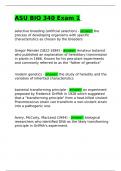
-
ASU BIO 340 Exam 1
- Exam (elaborations) • 31 pages • 2024
-
- $14.99
- + learn more
selective breeding (artificial selection) the process of developing organisms with specific characteristics as chosen by the breeders Gregor Mendel () Amateur botanist who published an explanation of hereditary transmission in plants in 1866. Known for his pea-plant experiments and commonly referred to as the "father of genetics" Previous Play Next Rewind 10 seconds Move forward 10 seconds Unmute 0:00 / 0:15 Full screen Brainpower Read More modern genetics the st...

-
ATI TEAS EXAM----------LIFE SCIENCE QUESTIONS WITH COMPLETE SOLUTIONS
- Exam (elaborations) • 17 pages • 2023
-
- $11.99
- + learn more
The eight levels of taxonomy hierarchy (biological classification system): correct answer: Domain, Kingdom, Phylum, Class, Order, Family, Genus, Species. What does the domain level consist of? correct answer: Archea, Eukarya, and Eubacteria. ***Eukarya consists of: animailia, fungi, plantae, and protista. *** Archea consists of: archeabacteria. ***Eubacteria consists of: eubacteria. Binomial nomenclature: correct answer: Used when classifying individual species, the Latin name of t...
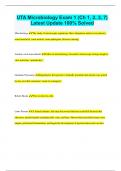
-
UTA Microbiology Exam 1 (Ch 1, 2, 3, 7) Latest Update 100% Solved
- Exam (elaborations) • 7 pages • 2024
- Available in package deal
-
- $9.99
- + learn more
UTA Microbiology Exam 1 (Ch 1, 2, 3, 7) Latest Update 100% Solved Microbiology The study of microscopic organisms. Have ubiquitous nature (everywhere), some beneficial, some neutral, some pathogenic (disease-causing) Antoine van Leeuwenhoek Father of microbiology. Invented a microscope strong enough to view microbes "animalcules". Giralamo Fracastoro Regarded as first person to formally postulate that disease was spread by tiny invisible seminaria "seeds of contagion". Robe...
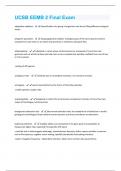
-
UCSB EEMB 2 Final Exam Exam full solution packxam Questions and Answers 2024
- Exam (elaborations) • 8 pages • 2024
- Available in package deal
-
- $7.99
- + learn more
adaptative radiation - diversification of a group of organisms into forms filling different ecological niches allopatric speciation - aka geographical isolation: biological pops of the same species become isolated from each other to an extent that prevents or interferes with gene flow allopolyploidy - individual or strain whose chromosomes are composed of more than two genomes each of which has been derived more or less complete but possibly modified from one of two or more species -matin...
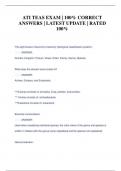
-
ATI TEAS EXAM | 100% CORRECT ANSWERS | LATEST UPDATE | RATED 100% The eight levels of taxonomy hierarchy (biological classification system
- Exam (elaborations) • 25 pages • 2024
- Available in package deal
-
- $12.99
- + learn more
The eight levels of taxonomy hierarchy (biological classification system): ANSWER: Domain, Kingdom, Phylum, Class, Order, Family, Genus, Species. What does the domain level consist of? ANSWER: Archea, Eukarya, and Eubacteria. ***Eukarya consists of: animailia, fungi, plantae, and protista. *** Archea consists of: archeabacteria. ***Eubacteria consists of: eubacteria. Binomial nomenclature: ANSWER: Used when classifying individual species, the Latin name of the genus and species is ...
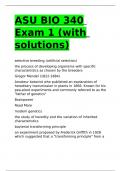
-
ASU BIO 340 Exam 1 (with solutions)
- Exam (elaborations) • 29 pages • 2024
-
- $14.99
- + learn more
selective breeding (artificial selection) the process of developing organisms with specific characteristics as chosen by the breeders Gregor Mendel () Amateur botanist who published an explanation of hereditary transmission in plants in 1866. Known for his pea-plant experiments and commonly referred to as the "father of genetics" Previous Play Next Rewind 10 seconds Move forward 10 seconds Unmute 0:01 / 0:15 Full screen Brainpower Read More modern genetics the study ...
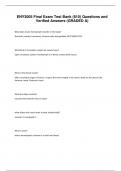
-
ENY3005 Final Exam Test Bank (810) Questions and Verified Answers (GRADED A)
- Exam (elaborations) • 129 pages • 2024
-
- $11.49
- + learn more
What does insect hemolymph transfer in the body? Nutrients, wastes, hormones, immune cells and peptides, BUT NEVER O2!! What kind of circulatory system do insects have? open circulatory system: hemolymph is in direct contact with tissues Brainpower Read More What is the dorsal vessel? Main circulatory organ of insects. It spans the entire length of an insect's body on the dorsal side. Anterior: aorta. Posterior: heart What are Alary muscles? muscles that hold the heart in...
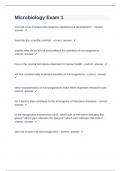
-
Microbiology Exam 1 Question and answers rated A+
- Exam (elaborations) • 12 pages • 2024
-
Available in package deal
-
- $13.99
- + learn more
Microbiology Exam 1 Question and answers rated A+ how did Louis Pasteur help disprove spontaneous generations? - correct answer describe the scientific method - correct answer explain why life could not exist without the activities of microoganisms - correct answer how is the normal microbiota important to human health - correct answer list four commercially important benefits of microoganisms - correct answer what characteristics of microorganisms make them importa...
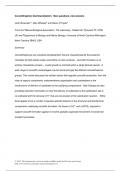
-
Coccolithophore biomineralization: New questions, new answers
- Exam (elaborations) • 19 pages • 2024
-
- $14.99
- + learn more
Coccolithophore biomineralization: New questions, new answers Colin Brownleea*, Glen Wheelera and Alison R Taylorb From the aMarine Biological Association, The Laboratory, Citadel Hill, Plymouth PL1 2PB, UK and bDepartment of Biology and Marine Biology, University of North Carolina Wilmington, North Carolina 28403, USA Summary Coccolithophores are unicellular phytoplankton that are characterised by the presence intricately formed calcite scales (coccoliths) on their surfaces. Coc...
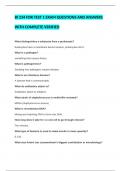
-
BI 234 FOR TEST 1 EXAM QUESTIONS AND ANSWERS WITH COMPLETE VERIFIED
- Exam (elaborations) • 23 pages • 2024
-
Available in package deal
-
- $9.99
- + learn more
BI 234 FOR TEST 1 EXAM QUESTIONS AND ANSWERS WITH COMPLETE VERIFIED What distinguishes a eukaryote from a prokaryote? Eukaryotes have a membrane bound nucleus, prokaryotes don't. What is a pathogen? something that causes illness. What is pathogenesis? Studying how pathogens causes disease. What is an infectious disease? A disease that is communicable. What do antibodies attach to? Antibodies attach to antigens. What strain of staphylococcus is methicillin resistant? MRSA (staphy...

Did you know that on average a seller on Stuvia earns $82 per month selling study resources? Hmm, hint, hint. Discover all about earning on Stuvia


